MARIANI’S
December
16, 2007
NEWSLETTER

"Making Waffles" (1550-60) by Joachin de Beuckalaer
NEW! Click esquire.com
to go to my new biweekly column at Esquire Magazine.
ARCHIVE: Readers may now access
an
Archive of all past newsletters--each annotated--dating back to July,
2003, by simply clicking on www.johnmariani.com/archive
SUBSCRIBE AND
UN-SUBSCRIBE: You may subscribe anyone you wish
to this newsletter--free of charge--by
clicking here.
In
This Issue
NEW YORK CORNER: PRIME HOUSE NEW YORK by John Mariani
NOTES FROM THE WINE CELLAR: A Dinner with Angelo Gaja by Brian Freedman
QUICK BYTES
CHOWING DOWN IN CHARLOTTE

by John Mariani
M5
4310 Sharon Road
705-909-5500
www.m5modmed.com
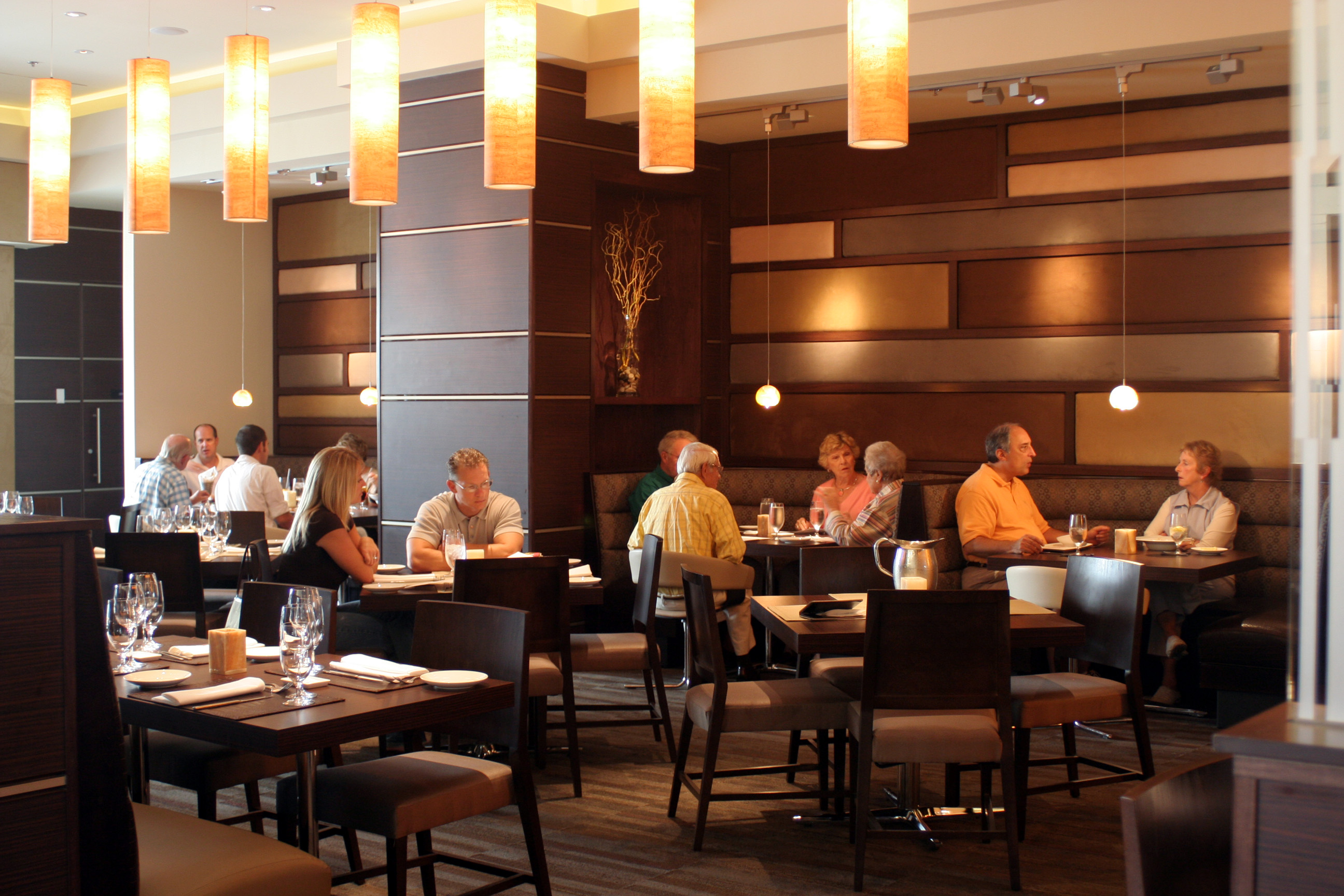 The cryptic name refers not to a BMW
model but instead to five owners who are all from Morgantown. The
concept, from the Harper's Group, is spot on Mediterranean, and since opening last year
it's been packed most night of the week--all 300 seats, inside and
out--by people who like the casual chic of the place and the
reasonable prices for food that is elsewhere merely trendy but here
quite convincing. Behind the stoves is exec chef Tom Condron, and
he's obviously done his homework: The flavors are authentic. And there
are more
than 30 wines by the glass, and flights of three from various
Mediterranean countries at $14.
The cryptic name refers not to a BMW
model but instead to five owners who are all from Morgantown. The
concept, from the Harper's Group, is spot on Mediterranean, and since opening last year
it's been packed most night of the week--all 300 seats, inside and
out--by people who like the casual chic of the place and the
reasonable prices for food that is elsewhere merely trendy but here
quite convincing. Behind the stoves is exec chef Tom Condron, and
he's obviously done his homework: The flavors are authentic. And there
are more
than 30 wines by the glass, and flights of three from various
Mediterranean countries at $14.The two main dining rooms are nicely glowing, with tube lights on the ceiling, neither too dark nor too light, although the use of abundant and various shades of brown and beige lends a certain drabness to the walls and banquettes, and the bare brown tables lend the room a certain coffee shop ambiance. The lounge features a swank 30-foot bar and suede walls. Outside, the patio (below) is prime real estate for people in good weather and seems to attract an unconscionable number of very pretty blond women. Service is professional and very cordial, and somehow, despite the crush of people most nights, the kitchen turns out its food in a timely pacing.
What the menu calls "Conversation Starters" involves well-wrought items like hummus with hot pita bread, an antipasti of artisanal cured meats, and a plate of artisanal cheeses with fruit, nuts and grilled walnut bread.
Then come the "Starters," and you could easily share and make a meal of them: A soft-centered burrata mozzarella comes with prosciutto, mushrooms, and a little truffle oil, and grilled figs also take on a robe of prosciutto, with mascarpone cheese and a lovely almond salad on the side. Very good indeed was a generous plate of potato gnocchi with mushrooms, Parmigiano, charred pepper and sweet corn--perhaps a little too much going on here but delicious nonetheless. A chopped Mediterranean salad with tomatoes, olives, cucumbers, and a phyllo bundle was, as these things go, rather bland.

Everyone who comes to M5 orders the flatbreads, like the one topped with prosciutto, pungent manchego and blue cabrales cheeses, figs and truffled arugula, or the one with Merguez sausage, caramelized onions, piquillo peppers, mushrooms, and Parmigiano.
If you have restrained yourself from eating too many appetizers, go for the very fine whole fish, one of which is served in "acqua pazza"--Italian for crazy water--with red snapper, tomato confit, charred peppers, olives, and the scent of rosemary. Among my favorite entrees were terrific, fat sea scallops "saltimbocca" with shell beans tagine style, with pork loin and arugula. Crispy, pressed and honeyed duck--a generous half of the bird--comes with fragrant Israeli couscous, Medjool dates, a bite of citrus and watercress salad, while braised lamb shank also gets a couscous treatment, with charred peppers, sweet-sour gremolata, raisin-onion confit, and chermoula. Fair but undistinguished was the "Tuna Sketches of Spain," wrapped in paper thin chorizo slices, with saffron rice, Rioja syrup, and a gazpacho-style salsa.
Flavors and ingredients overlap, but that is just as true of the cooking of southern Spain, Morocco, and the Mediterranean in general. That they are handled so well is what makes them so delectable throughout a meal. That M5 is go genuinely enjoyable and true to form is testament to how things have developed in Charlotte.
M5 is open for lunch and dinner every day. Appetizers run from $5-$12, main courses $17-$26.
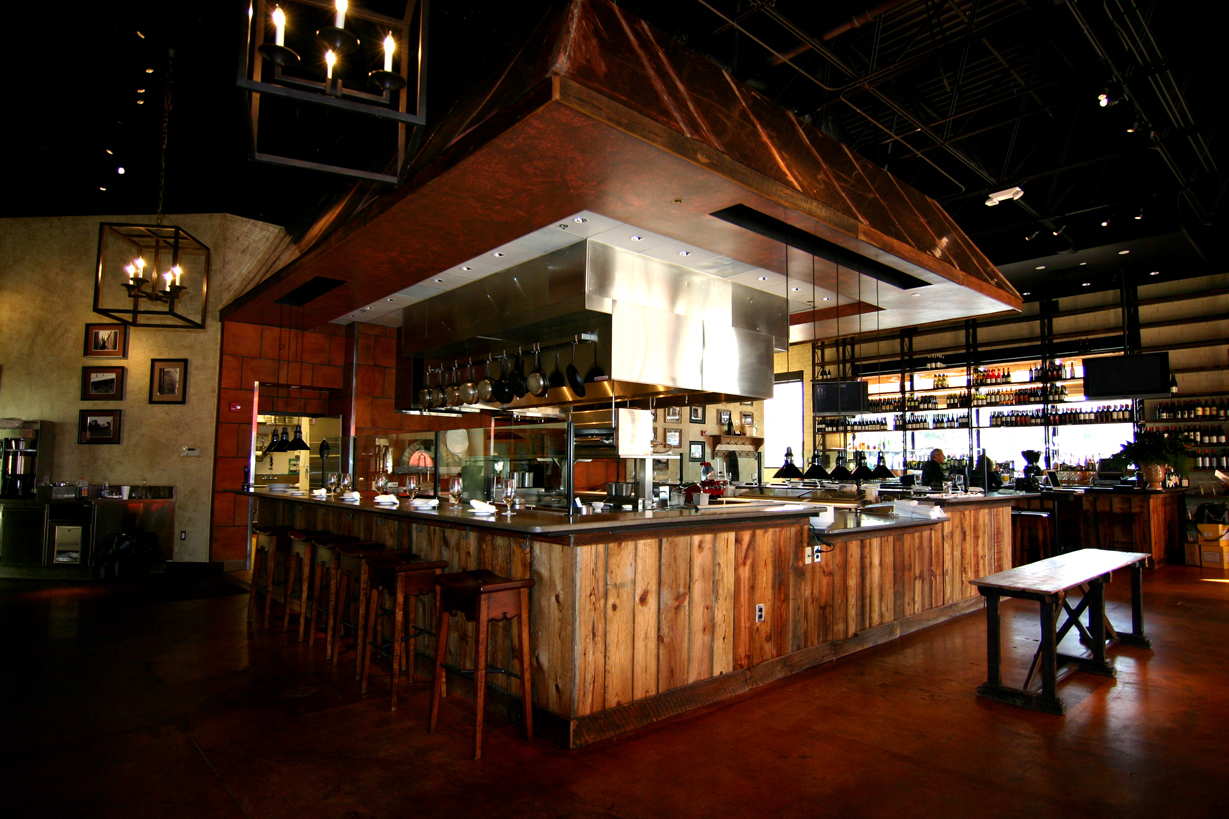 ROOSTER'S
WOOD-FIRED KITCHEN
ROOSTER'S
WOOD-FIRED KITCHEN
6601
Morrison Boulevard
www.roosterskitchen.com
Opened just a year, it has become very popular for all the obvious reasons: Chef
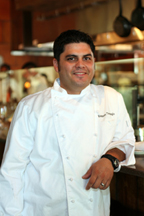
So you sit down and open the broadsheet of a menu and wag your head because you want to order everything. Should you begin with some chicken liver mousse, served in a sealed glass jar, with crispy country bread? Yes, you should, for it is one of the best I've ever tasted. Perhaps a cream of chanterelle soup, or an array of cured Serrano ham, coppa, Speck, and other meats (a generous sampler for the table runs $14), or a plate of cheeses. The spinach gnocchi have plenty of flavor, though too soft the day I tried them, and the Speck and cheese pizza is a tad thin of crust but equally as flavorful.
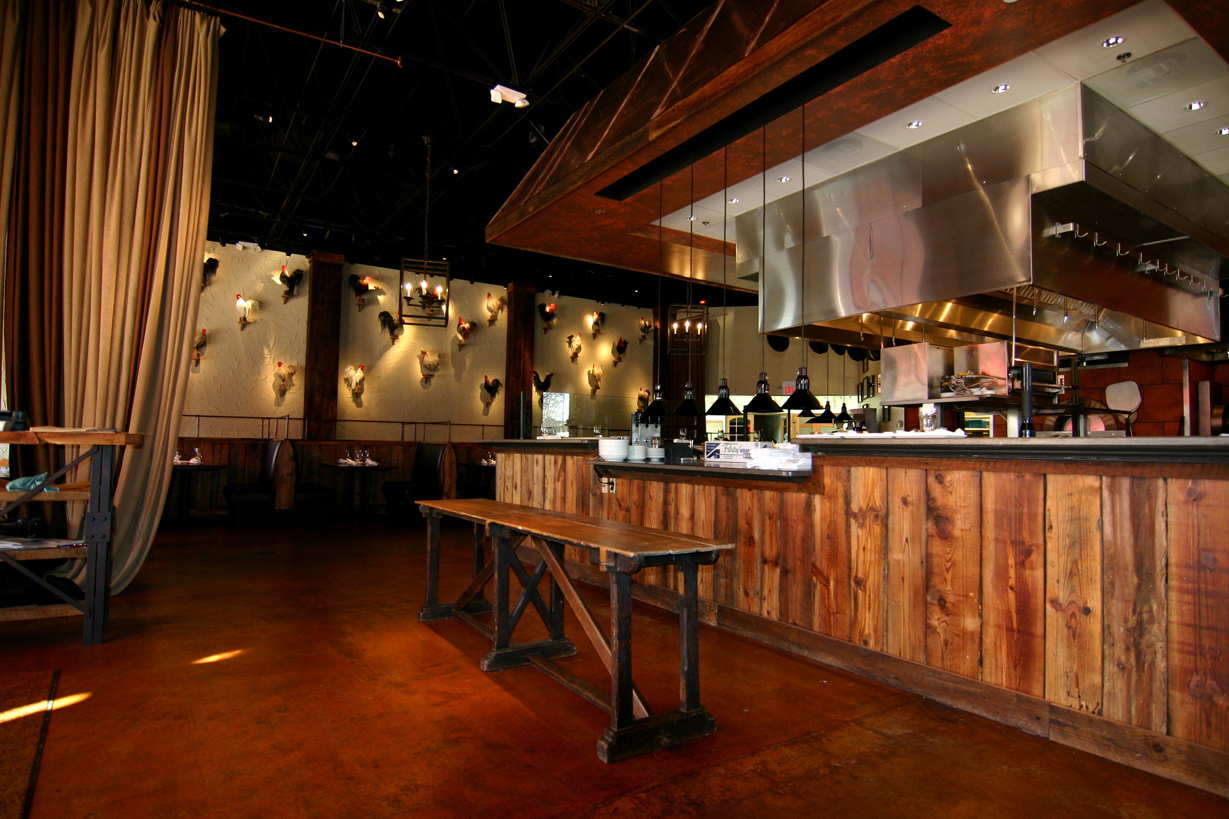 The
aromas off the
grill are inebriating as soon as you walk in, and your appetite builds
quickly. I
was really pleased with a flounder in a
maître d' butter--juicy, lightly sautéed--and the Carolina
pork
shoulder as good as any in Charlotte. That woody oven also turns
out mussels, chicken, Niman Ranch leg of lamb (at only $18!), and beef
short ribs. But I think what made me happiest was the marvelous
array of Southern-style vegetables, from pan-fried corn as sweet as
summer itself to crowder peas, white acorn peas, pink-eyed peas, and
other neglected species, all cooked perfectly (Southern cooks too often
overcook their
vegetables). I was delighted too with the pommes frites,
the crisply fried onion rings, and the stone-ground grits from Anson
Mills, the
organic producer in South Carolina that has revived the traditions of
Southern farm goods.
The
aromas off the
grill are inebriating as soon as you walk in, and your appetite builds
quickly. I
was really pleased with a flounder in a
maître d' butter--juicy, lightly sautéed--and the Carolina
pork
shoulder as good as any in Charlotte. That woody oven also turns
out mussels, chicken, Niman Ranch leg of lamb (at only $18!), and beef
short ribs. But I think what made me happiest was the marvelous
array of Southern-style vegetables, from pan-fried corn as sweet as
summer itself to crowder peas, white acorn peas, pink-eyed peas, and
other neglected species, all cooked perfectly (Southern cooks too often
overcook their
vegetables). I was delighted too with the pommes frites,
the crisply fried onion rings, and the stone-ground grits from Anson
Mills, the
organic producer in South Carolina that has revived the traditions of
Southern farm goods.For dessert there is an excellent panna cotta, creamy and nicely scented with vanilla.
Rooster's is a prime example of what regional American restaurants should be--devoted to American regional ingredients put to good use in making dishes that draw from global influences. Service is as friendly as you'd expect in North Carolina. This place has the look, and success, of a concept that could easily be rolled out, and it wouldn't be a bad thing for a lot of other American cities to embrace. For now, it's Charlotte's alone, and the locals know just how good it really is.
NEW YORK CORNER
by John Mariani
PRIMEHOUSE NEW YORK
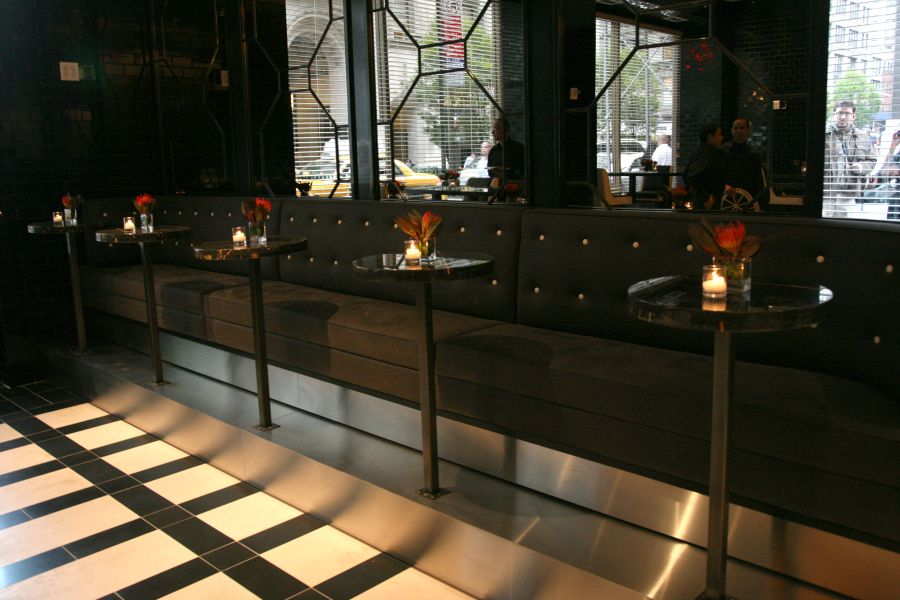
381 Park Avenue South (at 27th Street)
212-824-2600
www.primehouseny.com
Located in what had previously been the premises of the unmemorable Park Avenue Country Club, Primehouse is trying to distinguish itself from the zillion other steakhouses claiming to use USDA Prime beef by promoting its own Black Angus bull, who apparently has his work cut out for him siring beef cattle for the Chicago and New York operations. The beef is then dry-aged on the premises in the restaurant's "custom-built Himalayan rock salt-tiled aging room." (Question: Why Himalayan rock salt? Hands? Anybody?)
The restaurant is set in three rooms, a swanky, sexy bar upfront, where a very comely staff greets you and mixologist Eben Klemm creates nouvelle cocktails using herbs grown and snipped right there at the bar. The dining rooms beyond are oddly colorless, with cool beige stone columns that reminded one of my dinner companions of a 1970s bank. The black upholstered chairs and booths, and dark, bare naked tables don't bring much light into the ambiance, though mirrors help reflect and expand the light a bit. Noise levels, thank heavens, are not too bad.
 Jason Miller (below),
who is both exec chef and a partner here, spent 15 years working with
David Burke and has his mentor's same largess when it comes to how much
is put on the plate. The stack of very good onion rings alone is
about a foot high, the truffled Asiago cheese-spiced fried potatoes are
absolutely addictive, and, depending on how much you want to eat, there
are a 22-ounce filet mignon and two 12-ounce options, a 14-ounce
sirloin, several 20-ounce cuts, and a whopping 39-ounce porterhouse for
two. Within these beef listings is a special category of "Reserve
Cuts," that include 36-, 40-, and 65-day dry aged 20-ounce bone-in
steak. This last eclipses just about every age limit I've seen
around the steakhouse circuit, and just matching Craftsteak's
65-day New York strip.
Jason Miller (below),
who is both exec chef and a partner here, spent 15 years working with
David Burke and has his mentor's same largess when it comes to how much
is put on the plate. The stack of very good onion rings alone is
about a foot high, the truffled Asiago cheese-spiced fried potatoes are
absolutely addictive, and, depending on how much you want to eat, there
are a 22-ounce filet mignon and two 12-ounce options, a 14-ounce
sirloin, several 20-ounce cuts, and a whopping 39-ounce porterhouse for
two. Within these beef listings is a special category of "Reserve
Cuts," that include 36-, 40-, and 65-day dry aged 20-ounce bone-in
steak. This last eclipses just about every age limit I've seen
around the steakhouse circuit, and just matching Craftsteak's
65-day New York strip.Frankly I am not at all sure that such long-term aging, obviously within carefully maintained parameters of cold and humidity, really improves the flavor of beef, just as keeping whiskies in barrels beyond 12 years is regarded by many master blenders and connoisseurs as doing nothing more for the spirits. Indeed, my favorite steak at Primehouse New York was the 14-ounce sirloin, whose age is not listed on the menu. Here was a near perfect, beautifully aged piece of beef, with all the beef-iness I remember from sirloins 20 years ago, before USDA Prime got dumbed down. Impeccably charred on the outside and medium-rare within, it had juice, sweetness, saltiness, and a faint pungency you just don't find in beef today,
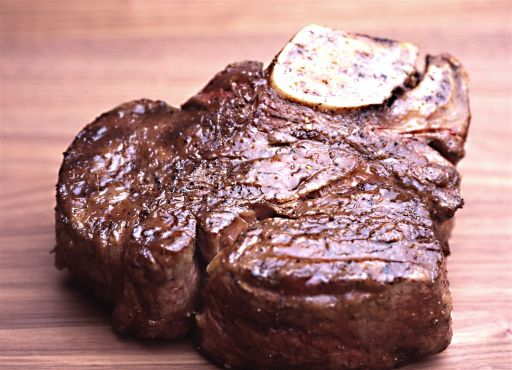 and almost never outside the most
established NYC steakhouses like Palm, Ben Benson's, Peter Luger,
Spark's, and Smith & Wollensky.
and almost never outside the most
established NYC steakhouses like Palm, Ben Benson's, Peter Luger,
Spark's, and Smith & Wollensky.Petite Bone-in Filet
The 65-day old steak was very good but its age didn't seem to add much to it. A 12-ounce petite filet with a "Lite Age" was delicious, and an "Unrack of lamb" came as juicy chops off the bone (why oh why?--the gnawing the bones is half the fun!) and some fatty spareribs with spiced citrus jam. As with those fabulous onion rings, other sides rang true, including very good creamed spinach. Optional accompanying steak sauces--peppercorn, béarnaise, blue cheese, and horseradish are mere gilding for the lily.
Most appetizers are bright and quite appealing, from a zesty combo of romaine lettuce, tomato, and Maytag blue cheese to surf-and-turf composed of a big fat scallop and succulent, melt-in-the-mouth braised shortrib. But a crabcake, full of lump crab, had some herb of seasoning that made it taste slightly medicinal.
Desserts need work here, especially a chocolate soufflé that tasted starchy and undercooked.
Whether NYC needs another steakhouse--and there are more coming--is open to question, even though even the least of them seems packed most nights of the week. If Primehouse New York does not add anything particularly novel to the mix, its strong suit is the meat of the matter itself, which puts it into the top ranks among competitors around the city.
NOTES FROM THE WINE CELLAR
A Dinner with Angelo Gaja
by Brian Freedman
 The
wines of Angelo Gaja (below),
especially his single-vineyard
bottlings from Barbaresco and Barolo, are among the most sought-after
in the
world. Their reputation for excellence is, happily, based on the fact
that they
are downright delicious and often capable of aging for decades or more.
That’s
the good news.
The
wines of Angelo Gaja (below),
especially his single-vineyard
bottlings from Barbaresco and Barolo, are among the most sought-after
in the
world. Their reputation for excellence is, happily, based on the fact
that they
are downright delicious and often capable of aging for decades or more.
That’s
the good news.The bad news is that because of this reputation and because of the high prices they command both on release and on the auction block too many people just don’t drink them. They buy them, sure, and show them off to their friends like trophies from a particularly high-priced (and tasty) hunt. But fewer and fewer of these bottles are finding their way to the dinner table, which is where they really belong.
This was recently thrown into sharp relief during a tasting and dinner I had in Barbaresco with Angelo Gaja. In the beginning of the evening, he opened a number of his elegant 2004s, including the Barbaresco, the Sorì Tildin, the Costa Russi, and the Sorì San Lorenzo. These were rounded out by the 2003 Sperss and the 1988 vintage of the same bottling.
On their own they were every bit as dramatic as I’d come to expect of Mr. Gaja’s wines. The 2004 Costa Russi was one of my two personal favorites, rich with aromas of warm hazelnuts and the perfume of fresh white truffles. The palate was pure silk, and the flavors ran the gamut from grilled rosemary and thyme to ripe dark berry fruit to mocha. The other stand-out (in an entire tasting of standouts) was the 1988 Sperss, which was like the concentrated essence of white truffle.
But as stunning as these wines were in Mr. Gaja’s cellar, they reached their full potential, as I suppose they were always intended to, at the dinner table.
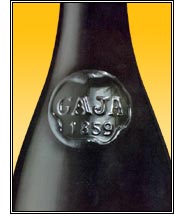
In order to showcase the wines in their most flattering light, Mr. Gaja brought most of the bottles we had just tasted to dinner at La Contea (below, left), an elegant, thoroughly Piedmontese restaurant in neighboring Neive (Piazza Cocito, 8; 0039 0173 67126/677558). After starting off with pickled veal tongue topped with ground hard-boiled egg yolk, we moved on to the truffle courses, which is where the wines really came into their own.
We had the truffles—in short supply this year because of the dry, hot summer—two ways: First as the kings used to enjoy them (shaved over tajarin, the local pasta that La Contea makes using the mind-boggling ratio of 30 red egg yolks to every 2 kilograms of flour), and second, as the less wealthy truffle hunters do (shaved over two eggs fried in an enamel skillet).
And while the expectation is that truffles will make anything they interact with taste better than it already does (why else pay such a premium for them?), what they did to the wines was nothing short of revelatory.
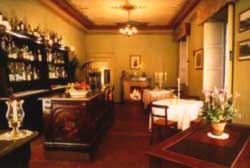 Even the youthful 2004s gained a sense of maturity
when
sipped alongside these dishes, with an earthiness that, while certainly
present just
beneath the surface when they were tasted on their own, was nowhere
near as
profound as it was next to the food. Sure, the wines will continue to
age and
develop for the next 10 or 20 years or more. And of course they will
only get
better and more complex as they rest in their bottles. But when enjoyed
in the
context of a meal like this, they gained a sense of gravitas that was
only
hinted at back in the cellar.
Even the youthful 2004s gained a sense of maturity
when
sipped alongside these dishes, with an earthiness that, while certainly
present just
beneath the surface when they were tasted on their own, was nowhere
near as
profound as it was next to the food. Sure, the wines will continue to
age and
develop for the next 10 or 20 years or more. And of course they will
only get
better and more complex as they rest in their bottles. But when enjoyed
in the
context of a meal like this, they gained a sense of gravitas that was
only
hinted at back in the cellar.What was most interesting, though, was the interaction between the 1988 Sperss and the truffle dishes. For while the 2004 Barbarescos gained a more up-front earthy component during the meal, that Sperss, which was so fabulously truffly in the cellar, regained the edge of sweet fruit I thought it had lost over the course of its bottle maturation. The truffle character of the wine and the perfume of the truffles themselves both paired perfectly with each other and canceled each other out to the extent that the flavor of both became less monolithic and far more complex. It was like seeing the wine in 360-degrees; had I just tasted it in the cellar and not at dinner, I never would have experienced that aspect of it.
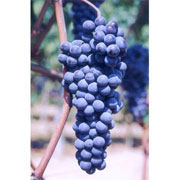
That, I think, was the point that Mr. Gaja was trying to illustrate: That no matter how expensive a wine is, no matter who produced it or in what seminal year the grapes were harvested, it will almost always show better when enjoyed alongside a well-paired meal.
Staring at a particular bottle in your cellar is perfectly fine. And tasting that wine on its own is unarguably instructive. But enjoying it as it was meant to be—alongside a great meal and with people who are just as enthusiastic about that bottle as you are—is when the wine will best express itself. That’s where the real fun begins.
Brian Freedman is a food and wine writer and wine
GUINNESS MIGHT WANT TO TAKE ANOTHER
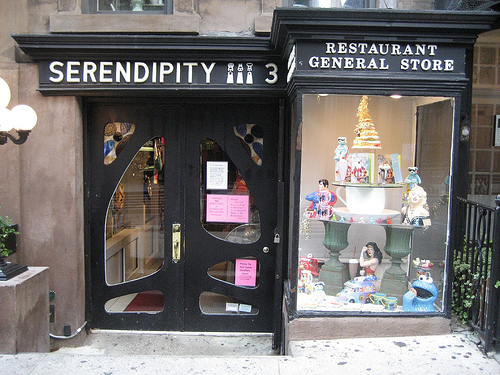
LOOK AT THOSE TRUFFLE SHAVINGS
In NYC the restaurant Serendipity 3 was offering a $25,000 dessert made with cocoa, edible gold and shavings of a truffle, called "The Frrrozen Haute Chocolate" and declared the most expensive dessert in the world by Guinness World Records.
TITILLATING TANTALIZING TIDBITS
 FROM PADMA
FROM PADMAQuotes by TV's Top Chef host Padma Lakshmi, touting her new cookbook, Tangy Tart Hot & Sweet, in Vanity Fair (December), as cited by New York Magazine (Nov. 14, 2007).
• On the Top Chef Emmy nomination: "[It] was a big f---ing deal.”
• On life without her ex-husband, Salman Rushdie: "I'm really f---ing sad."
• On her new cookbook: "Finishing the f---ing book was like being in labor for two years!”
• On hosting dinner party: "I pulled this out of my ass."
QUICK BYTES
Everett Potter's Travel Report:
Tennis Resorts Online: A Critical Guide to the World's Best Tennis Resorts and Tennis Camps, published by ROGER COX, who has spent more than two decades writing about tennis travel, including a 17-year stretch for Tennis magazine. He has also written for Arthur Frommer's Budget Travel, New York Magazine, Travel & Leisure, Esquire, Money, USTA Magazine, Men's Journal, and The Robb Report. He has authored two books-The World's Best Tennis Vacations (Stephen Greene Press/Viking Penguin, 1990) and The Best Places to Stay in the Rockies (Houghton Mifflin, 1992 & 1994), and the Melbourne (Australia) chapter to the Wall Street Journal Business Guide to Cities of the Pacific Rim (Fodor's Travel Guides, 1991). Click on the logo below to go to the site.
~~~~~~~~~~~~~~~~~~~~~~~~~~~~~~~~~~~~~~~~~~~~~~~~~~~~~~~~~~~~~~~~~~~~~~~~~
MARIANI'S VIRTUAL GOURMET NEWSLETTER is published weekly. Editor/Publisher:
John Mariani. Contributing Writers: Robert Mariani, Naomi
Kooker, Kirsten Skogerson, Edward Brivio, Mort
Hochstein, Suzanne Wright. Contributing
Photographers: Galina Stepanoff-Dargery, Bobby Pirillo. Technical
Advisor: Gerry McLoughlin.
Any of John Mariani's books below
may be ordered from amazon.com by clicking on the cover image.
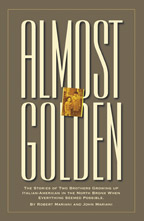 My
newest book, written with my brother Robert Mariani, is a memoir of our
years growing up in the My
newest book, written with my brother Robert Mariani, is a memoir of our
years growing up in the For those of you who don't think of the Robert and I think you'll enjoy this very personal look at our --John Mariani |
 |
 |
 |
 |
 |
 |
copyright John Mariani 2007

